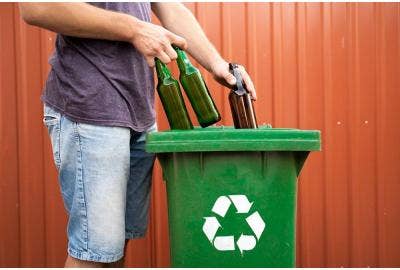Glass Recycling: What You Need to Know 
Glass recycling is the oldest form of recycling in the United States and is exactly how TricorBraun was born. More than 100 years ago, a hardworking man came up with the idea to sell used glass bottles in St. Louis. His brilliant idea resulted in the start of our parent company, originally named Northwestern Bottle Company, in 1902.
Glass recycling is the process of recycling waste glass into other usable products. Did you know that glass is infinitely recyclable? That gives it the edge compared to recycling of other materials. For every ton of glass recycled, more than a ton of natural resources and raw materials are saved, including 1,300 pounds of sand, 410 pounds of soda ash, 380 pounds of limestone and 160 pounds of feldspar, according to Keep America Beautiful.
Not all types of glassware are accepted for recycling at each glass recycling facility, which makes it important to check with your local recycling drop-off center. Most glass that is used for food packaging, such as salsa jars and iced tea bottles, can be recycled.
However, the following types of glass are not generally able to be recycled locally:
- Mirrors
- Ceramics, including cookware and decorative pieces
- Window Panes
- Automotive Glass
- Crystal
- Glass that is heat resistant, like Pyrex
How to Recycle Glass
When you are finished with a product contained in glass, it’s always a good idea to rinse it out before placing it in your recycling bin. This helps reduce odors and lessens the chance for contamination. Be sure to remove any closures that are not made of glass as well. In most cities, the easiest way to recycle glass is at your home by collecting and setting them by the curb on your recycling day.
If your community doesn’t offer curbside glass pick-up you may be able to find a local recycling system drop-off point. You can contact local recycling centers or city service departments to find this information.
Here’s step by step guide on how to recycle glass:
- 1. Remove all closures, including corks, from glass products.
- 2. Thoroughly rinse out the glass packaging before placing it in bins or bringing it to a recycling facility. This keeps odors to a minimum and reduces food contamination.
- 3. If you are able, remove all labels. Although they typically burn off in the recycling process, removing labels helps to keep emissions down and glass clean.
- 4. Once recycled, glass is sent off to a processor to be cleaned, sorted, and crushed.
- 5. The crushed glass will then be turned into cullet, where it will then be sold to manufacturers to later be used for new glass creations.
How to Recycle Broken Glass
If your glass bottle or jar is broken, you should still be able to recycle it. This is because all glass is eventually crushed while being prepared for recycling. Furthermore, broken glass can generally be recycled with your local curbside recycling provider. However, it is important that they be called first to ensure that the broken glass will be taken, as some drop-off facilities do not accept already broken glass.
Glass that is crushed and ready to be melted is called cullet. There are two types of cullet: external and internal. Internal cullet is made from defective products that were rejected by a quality control process during glass manufacturing, production offcuts, and transition phases of product changes.
External cullet is considered to be a waste glass. It has been collected and/or reprocessed for recycling. External cullet can be pre or post-consumer usage.

Where to Take Glass for Recycling
As mentioned previously, the easiest way to recycle glass is through curbside pickup. Contact your local trash collector to see if they run a recycling program. These curbside pickups are usually performed every other week.
Some cities or municipalities have recycling drop-off collection sites where you can bring your glass to be collected and recycled. The last place you can recycle would be through a recycling facility. A quick internet search should help determine what’s right for you.
To summarize, glass is the first type of packaging to be recycled. Glass is infinitely recyclable and can be used to create new products over and over without any loss in quality. We have learned how to prepare glass for recycling along with a few options on where you can drop off glass packaging for processing.
Interested in learning how to recycle plastic? Read our post that breaks down how to recycle plastic.
Plus, recycling glass has a positive impact on the environment as well. According to the Glass Recycling Coalition, recycling glass “...lessens demand for energy and cuts CO2 emissions.” While the Glass Packaging Institute tells us that, “Recycled glass reduces emissions and consumption of raw materials, extends the life of plant equipment, such as furnaces, and saves energy.”
And remember, at TricorBraun we supply the highest quality glass products which can also be recycled to help reduce glass waste! If you are looking for a high-end look with the environment in mind, look no further than our glass jars and bottles!
TALK TO A PACKAGING CONSULTANT
Whether you’re looking for a stock package or a groundbreaking custom design, TricorBraun’s proven process will guide your packaging decisions from napkin sketch all the way to the retail shelf.




